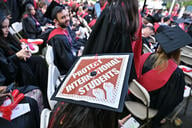You have /5 articles left.
Sign up for a free account or log in.
To: The Provost, Old Oak College
Re: Current Status of the Committee to Make Us Special
First, I’d like to thank you for the opportunity to chair this ad hoc committee. While I’m fairly certain my appointment was the result of my admittedly vociferous criticisms of just about every suggestion Old Oak’s senior administrators have made to improve our recruitment and retention of students, that doesn’t mean I didn’t take up the charge with the enthusiasm that such an opportunity truly deserves. The course release and travel stipend helped, too.
I’m sorry to say, though, that after nine months of weekly meetings and a great deal of research, the Committee to Make Us Special has come up mostly dry. This is not to say there were not ideas. In fact, at last count there were over 2,300 ideas shared by faculty, students, staff, alumni and anyone else who could find their way to our webpage.
We created four categories into which we sorted these ideas:
- We Like This but Could Never Afford It.
- We Like This, but It’s Been Done, Which Sort of Defeats the Purpose of Making Us Special.
- This Will Likely Undermine All That Our Founders Imagined for Us.
- Nice Idea but It Will Not Bring Us a Single Student.
Some ideas were category crossovers. For example, the lazy river in the shape of our initials was both a category 1 and category 2. It was also its own category: Ideas That Cannot Actually Be Implemented. We realized our particular moniker’s initials would create a very lazy river, one without the necessary water outflow. On the upside, it might have looked intriguing in a satellite photo -- something, perhaps, as Professor Whelan from the religion department pointed out, similar to a concrete crop circle, or, as Professor Martin from biology pointed out, a wastewater treatment plant (definitely not special).
One suggested category, Ideas Richard Russo Would Likely Satirize, ended up being too large a single category and so we deconstructed it into the above four (a process we acknowledge would undoubtedly be something Russo Would Likely Satirize -- one of our many meta moments).
We considered 22 possible new majors. We began with some of what we’ve come to realize are the usual suspects in such an undertaking. Nursing. Physical therapy. International business. Social justice. Video game design. Recognizing that we are behind the curve on them (a number of our peers and aspirants have already announced these particular programs), we began to think more creatively, combining the best features of some into interdisciplinary majors. Thus, global physical therapy, taught mostly online and focusing on injuries commonly sustained by those on mission trips to developing nations, was popular with the committee.
We did review a number of suggestions for new athletic programs that we might want to add -- water polo, fencing, water fencing (that’s still an emerging sport), trapeze. I must say I was astonished to discover how rapidly the circus arts in general are growing, and the irony of adding those to our campus was not, I assure you, lost on anyone. Twelve different sports with the terms “extreme” or “ninja” in the name were quickly set aside. In the end, the cost of facilities and equipment and the very hefty increase to our liability insurance premium made almost all of them unlikely. I say “almost all” because I’m happy to inform you that our bocce club will become a varsity sport next year. Professor Rubino and the rest of the Italian studies department are thrilled, as you might imagine. This idea may, however, belong in category 4.
Our Subcommittee on Enrollment Strategies (we thought about calling it “Extreme Enrollment Strategies,” but again, set that aside) examined some possibilities as well. One that you had suggested, bringing in our largest first-year class ever, was carefully vetted by our Sub-Subcommittee on Making at Least the Incoming Class Feel Special. Their determination was that this was a shortsighted approach. Our discount and acceptance rates would skyrocket, thus lowering our ranking in U.S. News & World Report, which would, in turn, make future recruitment efforts more difficult. Also, our housing staff would resign en masse. (I realize you think they’re all easily replaceable with cheaper, younger new professionals, but we saw what happened the last time we tried such a thing, and I don’t think the students without housing assignments for three weeks who lived in [yes -- admittedly very nice] tents will ever truly trust their alma mater again. Experience is worth something, is it not?)
In addition, four of our peer institutions announced last year the arrival of their largest first-year classes ever, and apparently at least three will do so again this year. Our demographics consultant made it clear this is not a bottomless well we’re peering down, so to speak. Although we could double our enrollment by attracting and admitting students who cannot pay anything, will need remedial assistance in every subject and don’t actually want to come to Old Oak, it seems this might not solve our long-term need for steady enrollment and revenue growth. In fact, after much number crunching, we believe it would ultimately sink us permanently. I realize that limiting enrollment growth will be a source of great disappointment to our president, who we know loves to announce such things at board meetings, but perhaps you could remind him that his retirement is within sight and his deferred compensation is within reach. That often seems to calm him.
Of course, I recall that one of your charges to our committee was to “investigate the role of the liberal arts for the future of Old Oak, indeed, for all of higher education.” Tall order, that. We did, however, do our best, creating yet another group: the Subcommittee to Read Everything That’s Been Written About the Liberal Arts in the Past Three Years.
Contrary to what you might have heard, those committee members did still find time to teach their classes and tend to their administrative duties, though not particularly well. Their work resulted in a book-length report (yes, they acknowledge the irony of adding to the pile of reports, books, films and tweets on this topic), which then led us to put the issue to a vote of the full committee. The results are instructive:
- Votes in favor of recommitting to the liberal arts nature of Old Oak: 12
- Votes in favor of abandoning the liberal arts completely: 12
Honestly, I have not witnessed such a deeply felt deadlock since the great hyena vs. dingo mascot controversy of ’97. As you know, the scars from that battle remain. Literally, in some unfortunate cases.
The alumni office representatives on our committee did take seriously your suggestion that we engage our alums in this process. We learned the following about our alums:
- They would be willing to help us recruit, if they were not feeling so overwhelmed by their monthly loan payments.
- They would be willing to provide internship sites for current students, if they were not feeling so overwhelmed by their monthly loan payments.
- They would be willing to come to campus for career-related events, if they were not feeling so overwhelmed by their monthly loan payments.
It’s worth noting that the one alumni-generated idea the committee felt was worth moving forward for review was the suggestion that we devote a portion of our endowment to alumni debt relief. That would indeed Make Us Special. It would also, our budget director determined, Make Us Broke.
As we conclude the work of our committee, recognizing that we have not succeeded at our appointed task, we feel a deep sense of melancholy, which I suspect you share. I’ve looked for harbingers of better times ahead, but as I suspect many of my counterparts on other campuses are also realizing, there are few. They are there, though, if one squints a bit and ignores demographics, economics and Malcolm Gladwell.
Perhaps you’ve seen the recent excellent movie The Martian? An astronaut named Watney is on a Mars mission, gets injured in a storm, is presumed dead and is left behind by his crew mates. Of course, he’s not dead. (That version of the movie would probably not have gotten green-lighted, although given our cultural fascination with zombies, who really knows?) Watney, fortunately, is a botanist, and so manages to stay alive for months, eating potatoes that he has miraculously grown in Mars soil fertilized by the human waste left behind by the crew. He is also good with a wrench and duct tape. Upon learning that Watney is alive, his crew mates ignore orders from NASA and turn around to get him. (Trust me -- this is all explained in appropriate scientific detail in the movie.) They are successful, bringing Watney back to Earth, where he fulfills his lifelong dream of becoming a professor (a plot twist less believable than the rescue, if you ask me).
I share this brief synopsis in order to end this memo on as positive a note as I can muster (and since there are 47 separate supporting documents attached, I don’t want to take up more of your time). As I ponder the work of our diligent committee, I can’t help but think of Watney, alone and frightened, yet determined to survive against ridiculous odds. What kept him alive till he was rescued was a clear-eyed view of just how dire his circumstances truly were, an ingenious use of shit and, ultimately, the hope of rescue by an intrepid band of space-traveling crew mates. If there is such a band out there, perhaps they will come our way. We are running low on potatoes.




